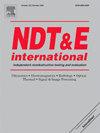基于刚度和拉伸预测的CFRP粘接质量超声评价
IF 4.5
2区 材料科学
Q1 MATERIALS SCIENCE, CHARACTERIZATION & TESTING
引用次数: 0
摘要
本研究旨在将超声透射光谱与有限元建模(FEM)相结合,建立碳纤维增强聚合物(CFRP)粘接接头粘接质量的无损评价框架,解决各向异性复合材料结构界面弱化检测的关键空白。采用水浸系统测量了界面粗糙度可控(600#至60#粒度)的CFRP试样的超声波透射系数。提出了一种基于混合粒子群优化的模拟退火(PSO-b-SA)算法,通过最小化实验光谱与理论光谱之间的差异来反向确定界面切向刚度(KT)。建立了基于内聚区模型(CZM)的有限元模型,结合倒KT和实验测量的i /II型断裂能(GIc, GIIc)来预测抗拉强度。随着界面粗糙度的增加,透射系数谱向更低的频率移动,KT降低了92%(从1.77 × 1014降至1.26 × 1013 N/m3)。有限元预测与实验抗拉强度在7%的误差内一致,证明了在不同的粘合条件下的鲁棒性。PSO-b-SA算法在理论光谱和实测光谱之间实现了98%的相关性,在收敛速度和稳定性方面优于传统的单参数优化方法。这项工作提供了一个系统的、非破坏性的框架,通过将超声指标与机械性能联系起来,来评估CFRP粘合质量。本文章由计算机程序翻译,如有差异,请以英文原文为准。
Ultrasonic evaluation of CFRP bonding quality using stiffness and tensile prediction
This study aims to develop a non-destructive evaluation framework for bonding quality in carbon fiber-reinforced polymer (CFRP) adhesive joints by integrating ultrasonic transmission spectroscopy with finite element modeling (FEM), addressing the critical gap in detecting interfacial weakening in anisotropic composite structures.
Ultrasonic transmission coefficients were measured using a water immersion system for CFRP specimens with controlled interfacial roughness (600# to 60# grit). A hybrid Particle Swarm Optimization-based Simulated Annealing (PSO-b-SA) algorithm was developed to inversely determine interfacial tangential stiffness (KT) by minimizing discrepancies between experimental and theoretical spectra. A cohesive zone model (CZM)-based FEM incorporating inverted KT and experimentally measured mode-I/II fracture energies (GIc, GIIc) was established to predict tensile strength.
The transmission coefficient spectrum shifted toward lower frequencies as interfacial roughness increased, correlating with a 92 % reduction in KT (from 1.77 × 1014 to 1.26 × 1013 N/m3). The FEM predictions aligned with experimental tensile strengths within 7 % error, demonstrating robustness across varying bonding conditions. The PSO-b-SA algorithm achieved >98 % correlation between theoretical and measured spectra, outperforming traditional single-parameter optimization methods in convergence speed and stability. This work provides a systematic, non-destructive framework for evaluating CFRP bonding quality by linking ultrasonic metrics to mechanical performance.
求助全文
通过发布文献求助,成功后即可免费获取论文全文。
去求助
来源期刊

Ndt & E International
工程技术-材料科学:表征与测试
CiteScore
7.20
自引率
9.50%
发文量
121
审稿时长
55 days
期刊介绍:
NDT&E international publishes peer-reviewed results of original research and development in all categories of the fields of nondestructive testing and evaluation including ultrasonics, electromagnetics, radiography, optical and thermal methods. In addition to traditional NDE topics, the emerging technology area of inspection of civil structures and materials is also emphasized. The journal publishes original papers on research and development of new inspection techniques and methods, as well as on novel and innovative applications of established methods. Papers on NDE sensors and their applications both for inspection and process control, as well as papers describing novel NDE systems for structural health monitoring and their performance in industrial settings are also considered. Other regular features include international news, new equipment and a calendar of forthcoming worldwide meetings. This journal is listed in Current Contents.
 求助内容:
求助内容: 应助结果提醒方式:
应助结果提醒方式:


